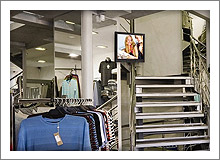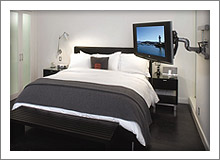![]() We sell a wide range of LCD monitors. Each monitor is designed to operate in a specific way for a variety of tasks. There is no single screen that is a perfect for every application, although many screens cover many applications very well. As with most things in life the difference boils down to price and what you get for your money. Professional LCD Public Display monitors may look very similar to domestic televisions but there are many reasons why they inevitably cost more.
We sell a wide range of LCD monitors. Each monitor is designed to operate in a specific way for a variety of tasks. There is no single screen that is a perfect for every application, although many screens cover many applications very well. As with most things in life the difference boils down to price and what you get for your money. Professional LCD Public Display monitors may look very similar to domestic televisions but there are many reasons why they inevitably cost more.
The most obvious difference between professional and domestic equipment is the warranty. Domestic televisions are designed to work for a few hours a day and usually come with a 1 or 2 year warranty. They are not covered under that warranty for use in a commercial application i.e. digital signage, timetables, public information etc. By contrast Public Display monitors are designed to operate for long periods of time over the course of many years and their warranty reflects this. Commercial grade screens are priced not only on their features but also on their duty-cycle or how they will be used. NEC for example has four different ranges of public display monitor.
The entry level E series are rated for 12 hours use. These screens are a cost effective solution for conference and corporate use where extended running times are not an issue. The NEC V series is the next tier up and is rated for 16 hours use. These screens are of use in digital signage applications and run long enough to cover most working hours. Finally the NEC P and X series monitors are designed for 24/7 operation. Very few applications actually require 24/7 operation but if you need a monitor to run indefinitely then these are the screens for you.
Professional displays have many additional features that make them stand apart from domestic screens. They have better thermal management as these screens can be installed in a variety of environments they need to be able to monitor and control their working temperature. Domestic televisions inevitably are located in the home and can be fairly confident of operating within a comfortable temperature range for domestic living.
In general professional displays will use higher quality components than most domestic sets. Features such as colour calibration, blackening defect free panels, anti-glare screens etc. are all come to commercial grade screens and help provide better looking and reliable monitors compared to a standard TV.


Remote control is a common feature of Public Display screens. This is not a simple handset you use for switching channels but rather a networked connection that enables monitoring of the displays status, changing inputs and settings as well as scheduling when the screens are powered on and off.
Daisy-chaining is a feature unique to large format public displays. The ability to take a single input source and stretch it across multiple displays to form a large video wall is something that your home TV has no use for but in the commercial world the ability to form extra large display walls from relatively cheap screens is a real advantage. LCD screens are available in very large sizes these days however those screens in excess of 90 inches come at a premium price and their own headaches in terms of installation and maintenance. Using multiple smaller, cheaper screens makes a lot of sense in this scenario.
There are many reasons to choose a professional public display monitor but many of them are hidden behind the screen. Despite their physical similarities to ordinary televisions, public display monitors are built to ensure prolonged life and reliable service and peace of mind.